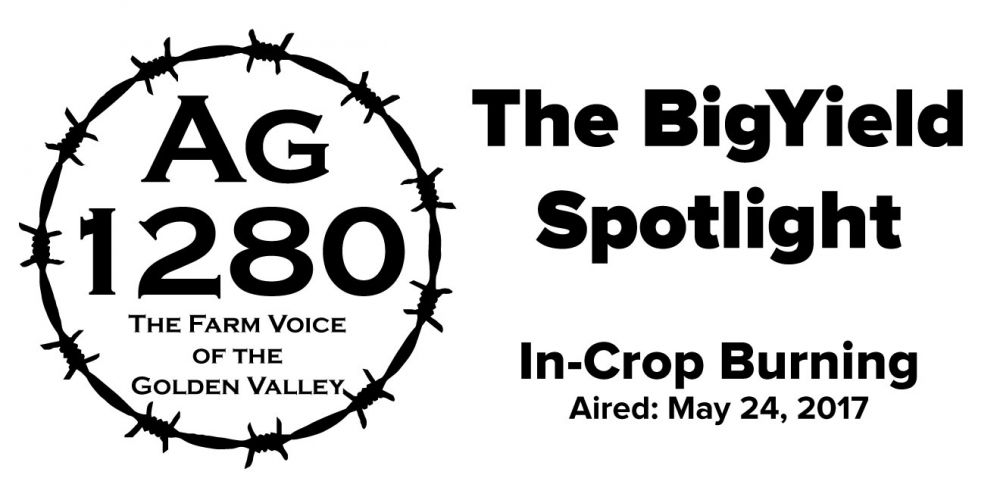
Kent Kauffman discusses using the BigYield Burners for weed and pest control while a crop is in the field.
Listen to Kent Kauffman of the BigYield.us team and Kyle Hill, Ag 1280 Farm Director, each Monday, Wednesday, and Friday on Ag 1280 KDKD-AM. The segments air at 7:15 am and again at 12:15 pm.
This segment originally aired on May 24, 2017.
Audio Transcriptions
Kyle: Time once again for a BigYield Spotlight. I’m Kyle Hill visiting in-studio with Kent Kauffman of BigYield.us. Glad to have you back.
Kent: Thanks for having me Kyle.
Kyle: Last week we talked about burning weeds and the advantages of doing this. Let’s recap our conversation from that.
Kent: Burning and flaming weeds, you’re running a flamethrower through the field and using the heat to kill the weeds. This heat vaporizes the water in the plant cell. This causes the weed to die. The flame is actually just the heat source, you’re not actually trying to burn or char the weed. The way you can test whether or not the weed will die is you can do what’s called the fingerprint test. Grab the leaf of a recently burned weed, put your thumb on it, and you will leave a fingerprint if the weed is going to die. You usually see the plant start to wilt a little bit before this happens, but not all weeds will have that visual wilt before you see them die.
Kyle: Last week we talked about broadcast burning. That’s where you burn an empty field. This week we’re talking about foliar burning. What’s the difference with that?
Kent: Foliar burning is when you are going through he field with your crops already up. The main issue here is that you’re trying to burn the growth portion of the weed, which is usually the top of the weed. It can vary depending on some weeds, but it will usually be the top portion of that weed. You also need to make sure you don’t burn the growth portion of your crops, which again is going to be the top portion of your crops. You are going to want your crops to be over a foot tall – both corn and soybeans – and you will want your weeds to be smaller. That way you get the top growth portion of the weed and you get underneath the growth portion of your crops.
Kyle: Let’s recap some of the advantages of burning.
Some of the advantages of burning are first, it’s a very low cost. The cost of the equipment is very reasonable, especially compared to any new sprayer cost. We also have kits that are even more reasonable than a fully functioning burning system. We run roughly 5 miles-per-hour when we are foliar burning, so we will go through four to seven gallons of liquid propane per acre. Especially with propane costs right now, it’s very reasonable to run a burner – especially compared to chemical costs and the fact that you’re getting insect control as well. Compared to cultivating, burning will allow you to kill the weeds in-row with your plant. It’s not just killing weeds in-between your rows but the weeds right next to your stalk as well. It will help reduce insect pressure – it smokes both insects and eggs with the heat. It’s very hard for insects to survive in 2,000 degree heat. With this, if you’re looking for more insect control then your timing – as far as morning, noon, and evening – will definitely make a difference. We have also had a lot of growers that were able to earn a premium for their crops because they were using burning instead of chemicals. There is a market demand for that.
Kyle: And of course we need to stress the importance of timing, especially with the safety surrounding flames. Are there times when you can’t burn your crops?
Kent: Yes, there are times when you can’t burn your crops. When your crops are very small, you’re going to have to let the growth portion grow higher than that flame. With corn, you can burn it as long as you can drive over it because you can keep the flame at the base of that plant. With soybeans, once you start to bloom then you will smoke the blooms. Some growers do actually prefer this so that they can burn the bottom two to three inches of the plant and not waste the soybean plants energy producing pods that are really hard to harvest. I actually noticed last year that we would get a one to three bushel yield increase if we burned a week prior to bloom because the soybean plant kind of liked that stress. It’s not enough to justify how much you’re spending on propane, but if you have to be in the field anyways, it’s a nice benefit. You also want to be careful about when you are doing things like broadcast burning. The wind will blow that heat around. Foliar burning you just have to be careful about things catching on fire in the field.
Kyle: This is quite a delicate procedure here with foliar burning. There seems to be a lot to discuss. If anyone has questions about this procedure or anything that BigYield.us has available, how can they get ahold of you.
Kent: They can reach us online at www.BigYield.us. They can call our toll-free line, 844-242-4367. They can stop by the research farm off of 7 highway. It’s easy to see, we have giant signs. They can check us out on Facebook as well.
Kyle: Kent once again to catch up with you and get your perspective on this and other topics throughout the week with BigYield.us
Kent: Thanks Kyle.
 BigYield High Yield Soybeans, High Yield Corn, and High Yield Wheat
BigYield High Yield Soybeans, High Yield Corn, and High Yield Wheat



